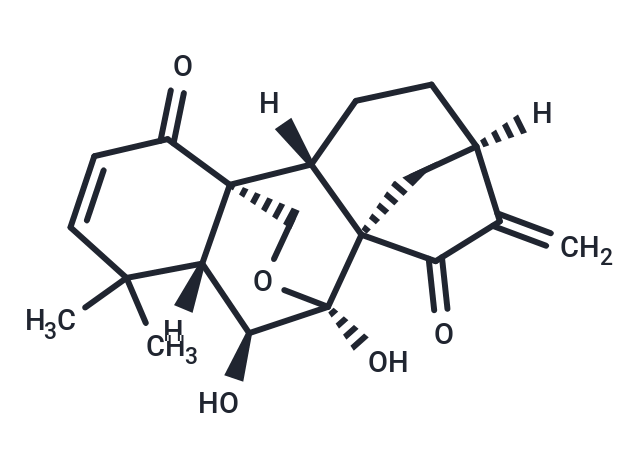Shopping Cart
Remove All Your shopping cart is currently empty
Your shopping cart is currently empty
Eriocalyxin B induces apoptosis and cell cycle arrest in pancreatic adenocarcinoma cells through caspase- and p53-dependent pathways, should be considered a candidate for pancreatic cancer treatment; it is a specific inhibitor of STAT3, it directly targets STAT3 through a covalent linkage to inhibit the phosphorylation and activation of STAT3 and induces apoptosis of STAT3-dependent tumor cells.

| Pack Size | Price | USA Warehouse | Global Warehouse | Quantity |
|---|---|---|---|---|
| 1 mg | $313 | In Stock | In Stock | |
| 5 mg | $689 | In Stock | In Stock | |
| 10 mg | $973 | In Stock | In Stock | |
| 25 mg | $1,430 | In Stock | In Stock | |
| 50 mg | $1,930 | In Stock | In Stock | |
| 100 mg | $2,630 | - | In Stock | |
| 1 mL x 10 mM (in DMSO) | $736 | In Stock | In Stock |
| Description | Eriocalyxin B induces apoptosis and cell cycle arrest in pancreatic adenocarcinoma cells through caspase- and p53-dependent pathways, should be considered a candidate for pancreatic cancer treatment; it is a specific inhibitor of STAT3, it directly targets STAT3 through a covalent linkage to inhibit the phosphorylation and activation of STAT3 and induces apoptosis of STAT3-dependent tumor cells. |
| In vitro | In this study, we demonstrated that Eriocalyxin B was efficacious in experimental autoimmune encephalomyelitis (EAE), an animal model for multiple sclerosis. Treatment with Eriocalyxin B led to amelioration of EAE, which correlated with reduced spinal cord inflammation and demyelination. Eriocalyxin B treatment abolished encephalitogenic T-cell responses to myelin oligodendrocyte glycoprotein in an adoptive transfer EAE model. The underlying mechanism of Eriocalyxin B-induced effects involved inhibition of T helper (Th) 1 and Th17 cell differentiation through Janus Kinase/Signal Transducer and Activator Of Transcription and Nuclear factor-κB signaling pathways as well as elevation of reactive oxygen species[1] |
| Molecular Weight | 344.4 |
| Formula | C20H24O5 |
| Cas No. | 84745-95-9 |
| Smiles | [H][C@@]12C[C@@]3(C(=O)C1=C)[C@@]([H])(CC2)[C@@]12CO[C@]3(O)[C@@H](O)[C@]1([H])C(C)(C)C=CC2=O |
| Relative Density. | 1.37 g/cm3 (Predicted) |
| Color | White |
| Appearance | Solid |
| Storage | keep away from direct sunlight,store under nitrogen | Powder: -20°C for 3 years | In solvent: -80°C for 1 year | Shipping with blue ice/Shipping at ambient temperature. | |||||||||||||||||||||||||||||||||||
| Solubility Information | DMSO: 55 mg/mL (159.7 mM), Sonication is recommended. | |||||||||||||||||||||||||||||||||||
Solution Preparation Table | ||||||||||||||||||||||||||||||||||||
DMSO
| ||||||||||||||||||||||||||||||||||||
| Size | Quantity | Unit Price | Amount | Operation |
|---|

Copyright © 2015-2025 TargetMol Chemicals Inc. All Rights Reserved.